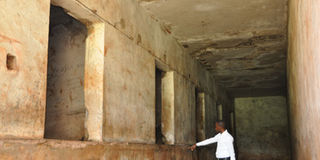Dark tourism, an untapped gem

The abandoned torture chambers that were used to extract information from suspects during Idi Amin’s regime. The chambers were constructed in 1971. Photo by Eronie Kamukama
The harrowing tales of indiscriminate extra-judicial killings under former Uganda president Idi Amin that earned his rule the euphemism “the reign of terror” can haunt any human being. Out of curiosity and a need to live through this history, I arrive at the Lubiri, Mengo palace on a Tuesday morning. The palace is quiet except for the king’s imposing mansion.
According to Allan Kakembo, a tour guide, the cream building also called Twekobe bears an ancient architectural design King Daudi Chwa admired on his visit to England.
It was constructed in 1922 but in 1966, it was destroyed after former president Milton Obote attacked the palace to get rid of Kabaka Muteesa II. To this day, no one, not even a king has lived in the Twekobe.
In front of Twekobe is a non-functional green cannon Amin reportedly acquired from former Libya leader Muammar Gaddafi and is displayed to commemorate the attack on the palace.
On the far left are the remains of Kabaka Muteesa II’s English and American cars, a rusty Rolls Royce, a Bentley and a Cadillac.
Chambers of death
Far below King Daudi Chwa’s desolate palace lies Amin’s torture chambers. They are unkempt and the grass around them is overgrown.
As we get closer, five prison-like rooms emerge. Except for the white paint stained with ink and soil from markings of those who lost their loved ones, the bricks and cement still hold the structure together.
What remains of this gloomy structure is now home to hundreds of bats. It is there that Amin conducted horrifying acts between 1973 and 1979.
Kakembo says the chambers had been constructed as an armoury by the Israelis under the directive of Amin in 1971.
However, when he got intelligence that Obote was working with some Ugandans to overthrow him, he withdrew the weapons stored at the armoury and started arresting people suspected to be working with Obote. And the torture began.
“The chambers had an electrified gate.
Whenever it rained the ground would be flooded with water but in dry seasons, the soldiers would bring in the water.
When soldiers brought in prisoners, the electricity would be switched on and off, and in order to extract information, they would ask the suspects to walk through the water,” Kakembo narrates.
The prisoners would then be forced into the prison and according to Kakembo, some died from starvation and suffocation while others were electrocuted in the water. Most bodies would then be dropped on roadsides within Kampala, the Kabaka’s lake and Lake Victoria.
It is estimated that in a period of six years, about 19,000 prisoners were killed at the chambers during Amin’s regime and 6,000 at the same place during Obote’s in his second reign.
A dark past
The Kabaka’s palace in Mengo, Idi Amin’s torture chambers, sight of Joseph Kibwetere’s Movement for the Restoration of the Ten Commandments of God massacre in Kanungu, Wamala tombs in Kampala and Uganda Martyrs Shrine Namugongo, represent Uganda’s very rich history that forms another area for tourism development -dark tourism.
Over the years, the number of people interested in dark tourism has grown. For UK national Diana Peel, Idi Amin’s torture chambers are the most eerie of all dark sites she has visited in Uganda. Lubiri, Mengo palace today receives about 50 foreign tourists in the peak season.
But in Uganda, dark tourism is a fairly new concept that people are gradually taking on.
Untapped resource
While studying illicit networks, Peel, who is the managing director of Changing Horizons, was curious about East Africa as a whole but for the most part, she found events caused by the Lord’s Resistance Army even more fascinating because of its forced recruits and child soldiers.
The criminologist, who finds human behaviour and motives for which people do things very thought-provoking, came to Uganda and read a lot of history in order to comprehensively understand the causes of the war.
What she found was very interesting but to her dismay, there was little to commemorate the history. “There were no museums, no statues and nothing to really tell you about what happened here,” she says.
As a country, this is an untapped tourism resource that can raise the number of visitors received and turn around tourism’s contribution to the country’s gross domestic product.
But besides earning revenue, the sites present lessons for many Ugandans to learn about unification and integration.
Peel admits that one challenge is that people are worried that the tour is a bit gruesome and reminds them of bad things that happened.
However, she says it is important for people to know what happened.
Uganda Tourism Board chief executive officer, Stephen Asiimwe, admits dark tourism has not been hyped even at the cultural level but says they are identifying sites that can be developed.
“The beauty about dark tourism is that it helps you to reflect and not go back to the old days. We have identified pockets such as Masulita in Luweero Triangle and Entebbe raid which are all good aspects to sell,” he says.




